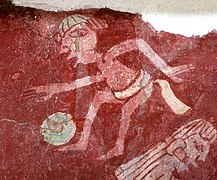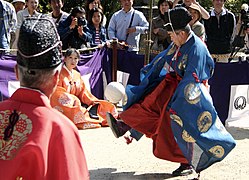Football
The Chinese competitive game cuju is an early type of ball game where feet were used, in some aspects resembling modern association football. It was possibly played around the Han dynasty and early Qin dynasty, based on an attestation in a military manual from around the second to third centuries BC.[15][16][17] In one version, gameplay consisted of players passing the ball between teammates without allowing it to touch the ground (much like keepie uppie). In its competitive version, two teams had to pass the ball without it falling, before kicking the ball through a circular hole placed in the middle of the pitch. Unlike association football, the two teams did not interact with each other but instead stayed on opposite sides of the pitch.[18] Cuju has been cited by FIFA as the earliest form of football.[4]
The Japanese version of cuju is kemari (蹴鞠), and was developed during the Asuka period.[19] This is known to have been played within the Japanese imperial court in Kyoto from about 600 AD. In kemari, several people stand in a circle and kick a ball to each other, trying not to let the ball drop to the ground. The Silk Road facilitated the transmission of cuju, especially the game popular in the Tang dynasty, the period when the inflatable ball was invented and replaced the stuffed ball.[20]
Ancient Greece and Rome
The Ancient Greeks and Romans are known to have played many ball games, some of which involved the use of the feet. The Roman game harpastum is believed to have been adapted from a Greek team game known as ἐπίσκυρος (episkyros)[21][22] or φαινίνδα (phaininda),[23] which is mentioned by a Greek playwright, Antiphanes (388–311 BC) and later referred to by the Christian theologian Clement of Alexandria (c. 150 – c. 215 AD). These games appear to have resembled rugby football.[24][25][26][27][28] The Roman politician Cicero (106–43 BC) describes the case of a man who was killed whilst having a shave when a ball was kicked into a barber's shop. Roman ball games already knew the air-filled ball, the follis.[29][30] Episkyros is described as an early form of football by FIFA.[31]
Native Americans
There are a number of references to traditional, ancient, or prehistoric ball games, played by indigenous peoples in many different parts of the world. For example, in 1586, men from a ship commanded by an English explorer named John Davis went ashore to play a form of football with Inuit in Greenland.[32] There are later accounts of an Inuit game played on ice, called Aqsaqtuk. Each match began with two teams facing each other in parallel lines, before attempting to kick the ball through each other team's line and then at a goal. In 1610, William Strachey, a colonist at Jamestown, Virginia recorded a game played by Native Americans, called Pahsaheman.[citation needed] Pasuckuakohowog, a game similar to modern-day association football played amongst Amerindians, was also reported as early as the 17th century.
Games played in Mesoamerica with rubber balls by indigenous peoples are also well-documented as existing since before this time, but these had more similarities to basketball or volleyball, and no links have been found between such games and modern football sports. Northeastern American Indians, especially the Iroquois Confederation, played a game which made use of net racquets to throw and catch a small ball; however, although it is a ball-goal foot game, lacrosse (as its modern descendant is called) is likewise not usually classed as a form of "football".[citation needed]
Oceania
On the Australian continent several tribes of indigenous people played kicking and catching games with stuffed balls which have been generalised by historians as Marn Grook (Djab Wurrung for "game ball"). The earliest historical account is an anecdote from the 1878 book by Robert Brough-Smyth, The Aborigines of Victoria, in which a man called Richard Thomas is quoted as saying, in about 1841 in Victoria, Australia, that he had witnessed Aboriginal people playing the game: "Mr Thomas describes how the foremost player will drop kick a ball made from the skin of a possum and how other players leap into the air in order to catch it." Some historians have theorised that Marn Grook was one of the origins of Australian rules football.
The Māori in New Zealand played a game called Kī-o-rahi consisting of teams of seven players play on a circular field divided into zones, and score points by touching the 'pou' (boundary markers) and hitting a central 'tupu' or target.[citation needed]
These games and others may well go far back into antiquity. However, the main sources of modern football codes appear to lie in western Europe, especially England.
Turkic peoples
Mahmud al-Kashgari in his Dīwān Lughāt al-Turk, described a game called tepuk among Turks in Central Asia. In the game, people try to attack each other's castle by kicking a ball made of sheep leather.[33]
Medieval and early modern Europe
Further information: Medieval football
The Middle Ages saw a huge rise in popularity of annual Shrovetide football matches throughout Europe, particularly in England. An early reference to a ball game played in Britain comes from the 9th-century Historia Brittonum, attributed to Nennius, which describes "a party of boys ... playing at ball".[34] References to a ball game played in northern France known as La Soule or Choule, in which the ball was propelled by hands, feet, and sticks,[35] date from the 12th century.[36]
The early forms of football played in England, sometimes referred to as "mob football", would be played in towns or between neighbouring villages, involving an unlimited number of players on opposing teams who would clash en masse,[37] struggling to move an item, such as inflated animal's bladder[38] to particular geographical points, such as their opponents' church, with play taking place in the open space between neighbouring parishes.[39] The game was played primarily during significant religious festivals, such as Shrovetide, Christmas, or Easter,[38] and Shrovetide games have survived into the modern era in a number of English towns (see below).
The first detailed description of what was almost certainly football in England was given by William FitzStephen in about 1174–1183. He described the activities of London youths during the annual festival of Shrove Tuesday:
After lunch all the youth of the city go out into the fields to take part in a ball game. The students of each school have their own ball; the workers from each city craft are also carrying their balls. Older citizens, fathers, and wealthy citizens come on horseback to watch their juniors competing, and to relive their own youth vicariously: you can see their inner passions aroused as they watch the action and get caught up in the fun being had by the carefree adolescents.[40]
Most of the very early references to the game speak simply of "ball play" or "playing at ball". This reinforces the idea that the games played at the time did not necessarily involve a ball being kicked.
An early reference to a ball game that was probably football comes from 1280 at Ulgham, Northumberland, England: "Henry... while playing at ball.. ran against David".[41] Football was played in Ireland in 1308, with a documented reference to John McCrocan, a spectator at a "football game" at Newcastle, County Down being charged with accidentally stabbing a player named William Bernard.[42] Another reference to a football game comes in 1321 at Shouldham, Norfolk, England: "[d]uring the game at ball as he kicked the ball, a lay friend of his... ran against him and wounded himself".[41]
In 1314, Nicholas de Farndone, Lord Mayor of the City of London issued a decree banning football in the French used by the English upper classes at the time. A translation reads: "[f]orasmuch as there is great noise in the city caused by hustling over large foot balls [rageries de grosses pelotes de pee][43] in the fields of the public from which many evils might arise which God forbid: we command and forbid on behalf of the king, on pain of imprisonment, such game to be used in the city in the future." This is the earliest reference to football.
In 1363, King Edward III of England issued a proclamation banning "...handball, football, or hockey; coursing and cock-fighting, or other such idle games",[44] showing that "football" – whatever its exact form in this case – was being differentiated from games involving other parts of the body, such as handball.







